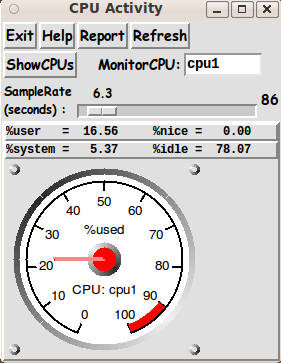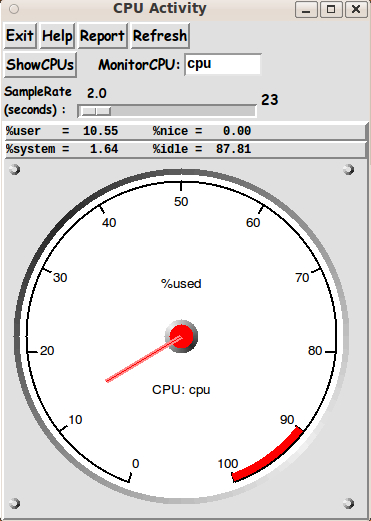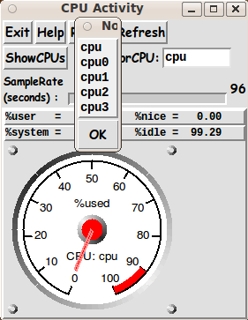|
This output is explained via the 'man proc' command.
See the section that starts at '/proc/stat'.
The first 4 numbers on each 'cpu' line are the amount of time --- measured
in units of USER_HZ (approx. 1/100ths of a second on most architectures)
--- that the system spent in
-
user mode,
-
user mode with low priority ('nice' mode),
-
system mode,
-
the idle task,
respectively.
The other numbers on each 'cpu' line are described in 'man proc'.
The time is measured from boot time.
The output from two consecutive queries can be used to get the
cpu-activity (user,nice,system,idle) over a sample time interval.
The 'cat /proc/stat' command is used to show the CPU 'ticks'
--- sometimes called 'jiffies', which are on the order of 1/100th of
a second --- in the categories user-nice-system-idle-etc --- for ALL the
CPU's of the computer --- as well as totals for all the CPU's.
Although Unix and BSD systems have many commands --- like 'free' and
'netstat' and 'df' --- that behave almost exactly as they do on Gnu/Linux,
the characteristics of the '/proc' file system of Linux may be rather
unique.
In other words, to get the following utility to work, one may
have to substitute another command wherever the 'cat /proc/stat' command
is used.
That command is used in 3 places in a shell script (code shown below).
The Tcl-Tk script, whose code is shown below, serves as a
GUI 'wrapper' or 'front end' for that shell script.
Note that the Apple Mac operating system is based on a BSD system, so
if there is a suitable command on BSD systems to get the 'cat /proc/stat'
data --- then it may be possible to implement this 'CPU-usage' utility
on Apple Mac systems with just a few changes.
Summarizing:
This utility is probably usable on BSD and Mac (and Unix)
systems with some changes to the shell script.
And for almost any Linux system with an 8.x Tcl-Tk 'wish'
interpreter installed, this utility should be usable with
essentially no changes.
---
The number of 'cpu*' lines:
In the example output above, you can see that there are 3 CPU's listed ---
'cpu', 'cpu0', and 'cpu1'.
The data for 'cpu' are totals of the data for the CPU's 'cpu0' and 'cpu1'.
On a home computer with just one CPU, there may be only one CPU-ID
in the listing --- 'cpu'.
I don't know for sure myself because my little netbook computers have
at least 2 CPU's (cpu0,cpu1) and my main desktop
computer has 4 CPU's (cpu0,cpu1,cpu2,cpu3).
Designing the Tk GUI
I decided to go with a single meter on the GUI --- rather than
2 meters, like in the 'memory-and-swap' and the 'network-activity'
Tk GUI's that I had devised before.
In fact, I patterned this GUI on the single-meter GUI that I used for
the 'file-system-usage' Tk GUI that I devised before.
Besides showing a 'percent-usage' meter (on a Tk canvas on the GUI),
I wanted to provide a means for the user to query the CPU ID's available
on the computer --- and to choose one of the CPU-ID's to monitor.
And I wanted to provide a Tk 'scale' widget on the GUI, by which the user
can specify, at any time, a new 'sampling rate' --- for getting the
CPU-activity data via the 'cat /proc/stat' command.
(Actually, the 'sampling rate' is a 'wait-time' = 'wave-length',
rather than a 'frequency'.)
I was able to implement that periodic-sampling ability by use of the
Tcl 'after' command, in the form
after $WAITmillisecs update_needles
This command is issued once to initialize the GUI --- and it is issued
within the 'update_needles' proc itself, to continue getting CPU
usage data, for a user-specified CPU-ID, via the 'cat /proc/stat' command.
Since, often, the 'ticks' for any of the CPU's are accumulating
rather gradually, a sampling rate of at least a couple of seconds is
needed to get reasonably accurate %-usage for the low-usage CPU's.
So the 'scale' widget is initialized at a rate of that magnitude.
And since any computer, even one with only one CPU, will probably have
the CPU-ID 'cpu' included in the output of 'cat /proc/stat', I decided
to initialize the monitoring with the CPU-ID 'cpu'.
I also wanted to supply a 'Refresh' button on the GUI, so that the
user can request at ANY TIME, a new query of the usage data for the
CPU-ID being monitored.
This is especially helpful if you have the sampling rate set at
10 seconds or more, and you want to intervene immediately
to change the sampling rate.
And, in case there is more than one CPU that is quite active,
I wanted to supply a 'Report' button on the GUI, so that the user
can see, at any time, the usage of ALL the CPU's on the computer
--- even a monster computer with 24 or more CPU's.
In putting together the code for this GUI, I drew heavily on the
'shadow-circle' technique of Marco Maggi to make nice looking meters.
And I included a 'red-line' (danger) area on the meter, like he did.
One rather unique thing about this implementation of the meter
(something not done by Maggi in his demo) is that the GUI window
and the canvas and the meter are resizable.
In other words, I spent quite a bit of effort in converting
Maggi's procs
So the user is able to resize the window and click on the 'Refresh' button
to get a bigger version of the meter and the needle position.
SOME GUI IMAGES
On the basis of these goals, I ended up with the GUI seen in the
following image.

Typically, there are not many 'ticks' accumulating in 'nice mode'.
So most of the 'activity' of a CPU is accumulating in the
'user' and 'system' modes.
I show the '%user' and '%system' numbers stacked above each other in a
couple of 'label' widget lines on the GUI.
Their sum will typically be the same as the %CPU value pointed to
by the needle.
---
The integer shown just to the right of the 'scale' widget is a sample-count.
I found that it is helpful to have this count displayed in cases when
the needle and numbers on the GUI are not changing perceptibly --- so
that the user is assured that the sampling is taking place, and at the
rate that is currently requested.
---
The 'ShowCPUs' button on the GUI can be used to show the available
CPU-ID's.
A small window pops up showing a list of CPU-ID's
--- as seen in the following image.

Below is an image that shows that one can change the 'CPU-to-monitor'
entry field so that a different CPU-ID is monitored --- in this
case the CPU-ID 'cpu1' --- the second of four CPU's on my desktop
computer.

When the GUI first comes up, the meter (its canvas) is sized
at about 200x200 pixels --- and the data shown is based on an initial
couple of executions of the 'cat /proc/stat' command --- from which
data for the 'cpu' CPU-ID is extracted.
The image below demonstrates that the user is able to resize the
window and click on the 'Refresh' button to get a bigger version
of the meter.

I had hoped to come up with a technique to avoid the 'aliasing' effect
on the needles --- but I did not devise a successful technique for any
of the 4 tachometer-meter scripts that I have done so far.
However, as 'retina display' monitors come into use more and more
(with resolutions above about 2000x1500 pixels), even without changing
the needle-drawing code in this script, you may find that the
'jaggies' are hard to see.
(I do not have such a monitor yet, so I cannot say for sure.)
CAPTURING THE GENERATED IMAGE:
When you get an image that you want to save,
a screen/window capture utility (like 'gnome-screenshot' on Linux)
can be used to capture the GUI image in a PNG or GIF file, say.
If necessary, an image editor (like
'mtpaint' on Linux) can be used to crop the window capture image.
(The image could also be down-sized with the editor
--- say, to make a smaller image suitable for
presentation in an email or on a web page.)
This is the technique that I used to prepare the images
that I posted above, to show some GUI features of this utility.
However, I replaced the relatively large PNG files that came from
the 'mtpaint' editing step with smaller JPEG files that were created
by the ImageMagick 'convert' command.
DESCRIPTION OF THE CODE
Below, I provide the Tk script code for this 'CPU-usage'
display utility.
I follow my usual 'canonical' structure for Tk code
for this Tk script:
|




